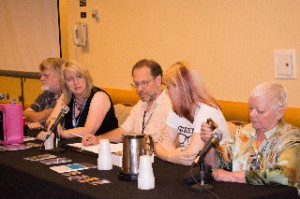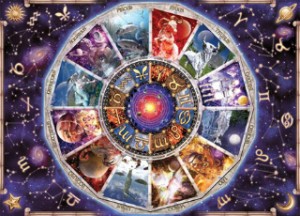(Astrology as a method of character development)
Thanks to Ken Farmer for reminding me of this trick.
 One of the things you need to know in order to develop your characters is their personality. One “quick and dirty” trick to getting a start on this is to use astrology.
One of the things you need to know in order to develop your characters is their personality. One “quick and dirty” trick to getting a start on this is to use astrology.
I’m not necessarily advocating astrology – or even stating whether or not I believe in it – but any good astrology website will give you a great little personality profile. That will give you a starting place for your character’s development.
You can go about this in two basic ways:
- Pick a random birthdate for your character and investigate the sign associated with that birthdate.
- Read through an astrology site and see if any of the personality charts sound like your character.
Let’s look at how this works.
Here’s what the website has to say about Gemini (Chance’s sign):
“A Gemini can change his clothes, his job, his love life or his residence as fast as he changes his mind, and that’s pretty fast. Finding a good example to study may keep you hopping. You could try a bookstore. He’s a browser, because he can get the gist of the contents in a brief scanning of the pages. (It’s no accident that John F. Kennedy was a speed reader.) Mercury people also have that nasty habit of reading the last page first.
When you’ve found this quicksilver person, study him carefully, even if you do get exhausted following him around. The first thing you’ll notice is a nervous energy that fairly snaps, crackles and pops in the air around him. An occasional Gemini will speak slowly, but most of them talk fast. All of them listen fast.
Man or woman, Gemini is impatient with conservative stick-in-the-muds, or with people who can’t make up their minds where they stand on particular issues. Gemini knows where he stands, at least for the moment.
Unless there’s a conflicting ascendant, the Gemini build is generally slender, agile and taller than average. Many of them have small, sharp features, as if they were cut in a cameo. You’ll find some with brown eyes, of course, but the majority of those ruled by Mercury will have beautiful, crystal-clear hazel, blue, green or gray eyes that twinkle and dart here and there. Geminis never rest their eyes on one object for more than a few seconds. In fact, their alert, quick-moving eyes are often the easiest way to recognize them. The complexion tends to be rather pale, yet they usually tan easily, and that’s the way to spot them in the summer. (In the winter, they often have wind bums from swooping down a ski slope.)
There’s an eagerness about Geminis, an immediate, sympathetic friendliness, and unusually quick, but graceful movements. The hair can be light or dark or both-like, streaked. Twins, remember? The nose is likely to be long and straight or dainty-in either case, probably well formed. There’s frequently a receding hairline in the men (from all that activity in the brain, perhaps), and both sexes normally have rather high foreheads.”
You can see that not only does a good chart give personality traits, but also some physical features. This can be quite useful for fleshing out that secondary character – or even figuring out what your main characters look like.
Try this technique the next time you’re wondering about one of your characters. I think you’ll be pleased with how much information you can get from an astrology chart.
Advanced Characterization (Michael Stackpole)
All plot comes out of the characters – their needs, goals and interactions
“Your job as a writer is to torture and confuse your readers by torturing and confusing characters.”
7 Traits of Enduring Characters:
- They are always something of a mystery – it is a seduction of the reader by the writer
- They are worthy of redemption – something makes you think they’re capable of change
- They score high on one end of the loyalty-treachery scale
- They are internally consistent and reliable, but capable of generating surprise
- They consistently score high (or low) on self-sacrifice scale
- There is a love story attached to them somewhere
- They are able to succeed at tasks we cannot do
Techniques:
- Character growth vs change – in episodic TV, the characters grow but don’t change (they end up in the same place as they started)
- Change is temporary – characters do what they have to do to get the job done
- Growth is permanent – an internal process as a result of external pressures where character makes a conscious decision to alter their behavior – that decision is key – the reader must know they have undergone growth
- Negative growth is a refusal to change – this is really tough to write – it results in the dissolution of character, and is brutal on reader and writer both
- Reversal – the character believes that a particular fact is true, but learns the opposite – they have to deal with brand new stuff they never thought existed before – the reader will also be shocked – this can be little personal reversals or hidden motivations – look for things you can make not true
- A great technique is betrayal – this creates an injustice, and readers inherently want to see it made right – the easiest are emotional betrayals – you can also have “reader betrayal” such as a love story that doesn’t quite sync up – also, betrayals that are mistakes – whichever sort you use, “emotional churning is absolutely what you want.”
“All fiction is the past erupting into the present.” ~James Sallis
Questions:
- The character wonders who they are, then you write out what they really are
- Who does character want to be? Who does character need to be?
- The character asks, “Who do they think I am? Who they want me to be? Who do they need me to be?”
Historical Fiction and Research (Bethany Kesler)
Start with Google/Wikipedia – get a general idea of what you want, then go for specifics.
Ask “What happened and why should I care?” Nothing happens in a vacuum.
Three Points:
- Authenticity (over accuracy – you’re not an actual historian)
- Plausibility
- Research
Research Tips:
- Look for history texts – brief overviews (“Complete Idiot’s Guide to __”)
- Books written in that era
- Journals and diaries – try college websites/inter-library loans
- Find a historian
- Genealogical societies
- Historical re-enactors
- Historical blogs – Tumblr etc
- Old maps
- Antique stores
- Family history
- Census
- Portraits, paintings
- Try the BBC for UK history
Ask yourself who your characters are? When and where did they exist? Knights in Scotland are very different from Knights in Japan
How you get around can show what era you’re in as well.
Do your general research – then write the novel – add specific research as you go along for what you need – just remember to make notes instead of constantly stopping to search
Today’s panels were The Rules of Writing, Historical Research, Characterization and Writing Mysteries. Here are Michael Stackpole’s suggestions.
Rules of Writing:
- Show, don’t tell. If you say “Bob was angry,” the reader is not engaged. If you say “Bob’s face reddened and he slammed his fist on the table” the reader must figure out what emotion is. Tell the trivial, show the significant. “On the road” chapters are pure crap (“Crap is a technical term” says Stackpole). Expand your work in the trivial sections if you need to.
- Write before you rewrite. You can have one chapter you have revised 24 times – or you can have 24 halfway decent chapters. You only become a novelist when you finish a novel – and only a novelist can edit a book. There is no such thing as a chapterist. The end of the novel will tell you where the novel begins. Just keep pushing forward. Take notes – keep a notebook for each novel. Correcting is OK – revising is not.
- Never settle for an easy way out. If you can say “I’ve seen this before” then make it tougher and nastier. “Cookie cutter books” are like eating potato chips – it beats not reading, but it’s just salty junk food.
- Double-duty scenes. Every scene should do more than one thing. Characterization plus ___. “I don’t need to know you know all the colors in the crayon box.” Description should be only a couple of paragraphs to give character an emotional response. Craft materially and content dense stories. This allows readers to get totally engaged. Readers are thinking “I know how this book ends” and the author says “No you don’t.” If the author succeeds in a logical manner, the reader will come back. Toss out vital clues during an emotional scene – you can’t be logical when you’re being emotional.
- Continuity Bolts. Llook for things you can reuse to save space for more emotion/action/etc. You can also compare new places to old places – “it was exactly like my usual bar only it had ferns.” Make the readers do all the work.
- Dealing with “he said,” “she said.” It’s a waste of space. “They act like a big fat comma to slow things down.” Make sure each character has a unique voice. Children speak in sentences that contain roughly as many words as their age in years. Professionals develop jargon. Educated characters use long sentences and long words of Latin derivation. Uneducated characters use short sentences, cursing, of German derivation. You can have characters name each other (“Well, Mr. Wolfe…”) You can also use descriptors – “John wiped the sweat from his brow. ‘I didn’t think you’d meet me here.'” The only time you use tags is to slow down the action. “I’m glad you made it out of the sewers,” HE SAID, “because the city’s on fire.”
- Conflict is the engine of the story. There are 5 basic conflicts: Man vs Self, Man vs Man, Man vs Society, Man vs Nature, Man vs Supernatural or Technological. (Nature has no intelligence behind the force; Supernatural has intelligence)
- Research everything, Choreograph everything. You know you’ve done enough research when you’re using it to avoid writing. Just jot down “Explain how engine works here” and keep writing. Research includes interviewing people. Everybody wants to be in a book! They’ll tell you things they shouldn’t, too.
Characterization:
People read for characters. It’s not Arthur Conan Doyle’s mysteries but Sherlock Holmes mysteries.
Characterization Techniques. Stackpole says, “None of these techniques is ‘The right one.’ It’s usually a mix and match of several.”
- Modeling: chose a real person as a model for your character (friends/family/famous person). A subcategory is physical modeling – just using a physical description of someone. Problems: a) unless you are actually writing “roman a clef” (every character is modeled on a real person but names are changed to avoid lawsuits), you may pick the wrong model for your story; b) you may adhere too rigidly to the model and stunt character’s growth; c )internal consistency suffers because you can’t tell what is in someone’s mind – people lie to themselves; d) you might hit too close to home with friends and family; e) if the model is recognized,the reader will be distracted or thrown out of story – or there might be lawsuits!
- Archetypes: like a casting role. This is very easy to create interactions (Black Hat vs White Hat) between characters. Problems: a) inherently shallow and you have to work very hard to develop characters; b) because archetypes are so familiar, you might not push yourself hard enough to develop the characters as unique individuals; c )if the archetype is recognized, the reader will be distracted or thrown out of the story.
- Compositing: a little bit of both of the above. Gives more depth to the characters, with strengths and weaknesses; more flexibility than strict modeling. Also good for modernizing historic figures. Problems: a it )might just not work (the mix of traits just might not logically flow, like Patton, the Drag Queen); b) you might have so much stuff that you put too much onto the page; c) you have the same problems as with modeling
- Organic Development: character grows as story grows. The character is a good fit for the story and progresses logically. Problems: a) inherent development eats up a lot of words – you’re feeling your way through. (You’ll either have to take out all the crap or figure out how to carry it forward); b) characters may go off in different directions than what you imagined; c) sometimes a secondary character hijacks the story -you can I) accept it and write the new story, II) save the character for a different story, III) use that character to knock some edges off the main character; d) a lot of their conflict tends to be internal and you need external trigger or ways to represent conflict (have the characters react and vent).
- Deliberate Design: these characters fit well into the story and conflicts are a lot sharper; they are highly internally consistent. Problems: characters may be too perfect – no room for growth (write the story of how they became perfect)
A Quick Technique: write two statements about the character that run in one direction, then write one statement that runs counter to those. “Blitzkrieg Characterization.” This creates an enigma and sets the hook. (“Bob always had a good word for everyone. He shook everyone’s hand and smiled. But you didn’t want him to take up the church offering.”)
The less the reader knows about the character, the better – they like discovering details. Also, don’t lock yourself in with too much detail.
Stackpole also says, “Forget the ‘fatal flaw’ – give your characters challenges instead.”
A good panel on creating characters – here are the highlights.
Q: How do you decide on a character?
Chelsea Quin Yarbro: I let them come to me. I had one character sit in my head for ten years before I found his story.
A.J. Scudiere: I have characters and plot lines bouncing around in my head, and occasionally they stick and go together – and then I start doing my research.
Gail Z. Martin: I start with a person with a problem, then start asking “What if?” and making it worse and worse. I also ask who else surrounds my main character.
David B. Coe: There’s a synergy to building a novel – character and plot and scene come to you in different ways and tie in and feed one another. It’s a braided process.
Richard Lee Byars: I ask what kind of character would make this situation particularly good – or bad.

More good advice:
Gail: When you have a strong protagonist, you have to have strong, interesting secondary characters to stand up to them.
Quin; I formed a habit when I was first starting out – I create backstories for the people I see around me.
David: Writing good characters and being a good friend are very similar. You have to be able to step into their lives and understand them.
Faith Hunter: Everyone who plans to be a writer should be an analytical reader. Buy a book and a set of colored highlighter pens, and highlight examples of what you’re trying to learn. “This is a great example of dialogue,” or “This is good characterization.” I even write an index on the blank pages in the back.
Oh, and Faith came in late, so I didn’t get a good picture of her.



